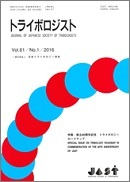Volume 66, Issue 12
Special Issue on Erosion and Its Countermeasures
Displaying 1-21 of 21 articles from this issue
- |<
- <
- 1
- >
- >|
Announcement
-
2021 Volume 66 Issue 12 Pages K12
Published: December 15, 2021
Released on J-STAGE: December 15, 2021
Download PDF (614K)
Contents
-
2021 Volume 66 Issue 12 Pages M12
Published: December 15, 2021
Released on J-STAGE: December 15, 2021
Download PDF (253K)
Serial Messages to Tribologists
-
2021 Volume 66 Issue 12 Pages 879
Published: December 15, 2021
Released on J-STAGE: December 15, 2021
Download PDF (243K)
Special Issue on Erosion and Its Countermeasures
-
2021 Volume 66 Issue 12 Pages 880
Published: December 15, 2021
Released on J-STAGE: December 15, 2021
Download PDF (183K)
Explanation
-
2021 Volume 66 Issue 12 Pages 881-886
Published: December 15, 2021
Released on J-STAGE: December 15, 2021
Download PDF (5000K) -
2021 Volume 66 Issue 12 Pages 887-893
Published: December 15, 2021
Released on J-STAGE: December 15, 2021
Download PDF (4009K) -
2021 Volume 66 Issue 12 Pages 894-899
Published: December 15, 2021
Released on J-STAGE: December 15, 2021
Download PDF (882K) -
2021 Volume 66 Issue 12 Pages 900-905
Published: December 15, 2021
Released on J-STAGE: December 15, 2021
Download PDF (3027K) -
2021 Volume 66 Issue 12 Pages 906-911
Published: December 15, 2021
Released on J-STAGE: December 15, 2021
Download PDF (3246K) -
2021 Volume 66 Issue 12 Pages 912-918
Published: December 15, 2021
Released on J-STAGE: December 15, 2021
Download PDF (1088K)
Up-to-date News Tribo-Episode -Tribo-Technology Award-
-
2021 Volume 66 Issue 12 Pages 919-921
Published: December 15, 2021
Released on J-STAGE: December 15, 2021
Download PDF (3866K) -
2021 Volume 66 Issue 12 Pages 922-924
Published: December 15, 2021
Released on J-STAGE: December 15, 2021
Download PDF (3678K) -
2021 Volume 66 Issue 12 Pages 925-927
Published: December 15, 2021
Released on J-STAGE: December 15, 2021
Download PDF (3622K) -
2021 Volume 66 Issue 12 Pages 928-930
Published: December 15, 2021
Released on J-STAGE: December 15, 2021
Download PDF (3640K)
Up-to-date News Tribo-Episode -Award for Young Tribologists-
-
2021 Volume 66 Issue 12 Pages 931-932
Published: December 15, 2021
Released on J-STAGE: December 15, 2021
Download PDF (3614K) -
2021 Volume 66 Issue 12 Pages 933-935
Published: December 15, 2021
Released on J-STAGE: December 15, 2021
Download PDF (3794K) -
2021 Volume 66 Issue 12 Pages 936-937
Published: December 15, 2021
Released on J-STAGE: December 15, 2021
Download PDF (4180K) -
2021 Volume 66 Issue 12 Pages 938-939
Published: December 15, 2021
Released on J-STAGE: December 15, 2021
Download PDF (3607K)
Short Paper
-
2021 Volume 66 Issue 12 Pages 940-945
Published: December 15, 2021
Released on J-STAGE: December 15, 2021
Advance online publication: October 07, 2021Download PDF (1656K)
Report of the Society
-
2021 Volume 66 Issue 12 Pages 946-947
Published: December 15, 2021
Released on J-STAGE: December 15, 2021
Download PDF (307K)
Index to Volume 66
-
2021 Volume 66 Issue 12 Pages M-66
Published: December 15, 2021
Released on J-STAGE: December 15, 2021
Download PDF (511K)
- |<
- <
- 1
- >
- >|
